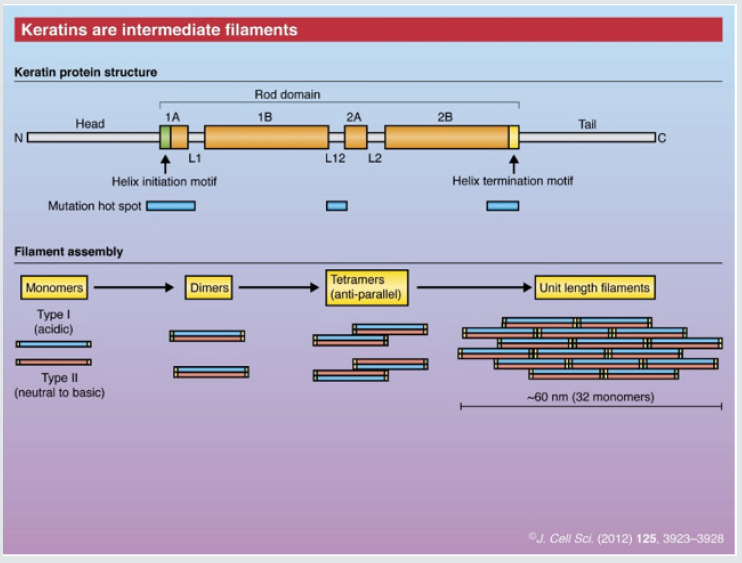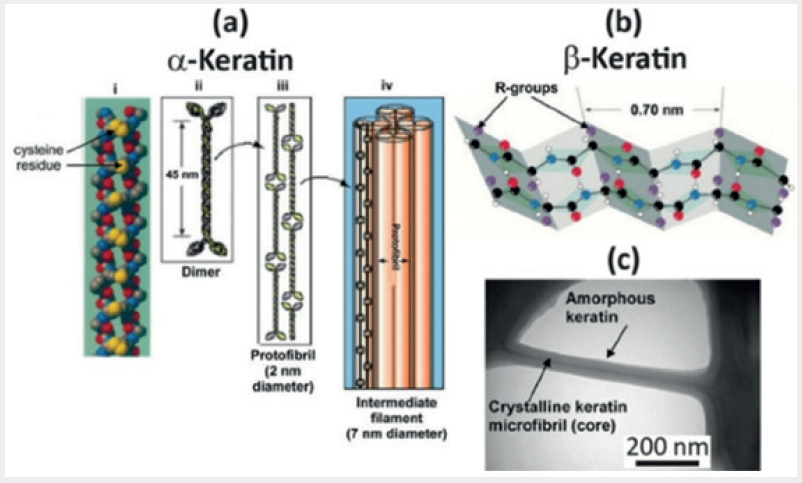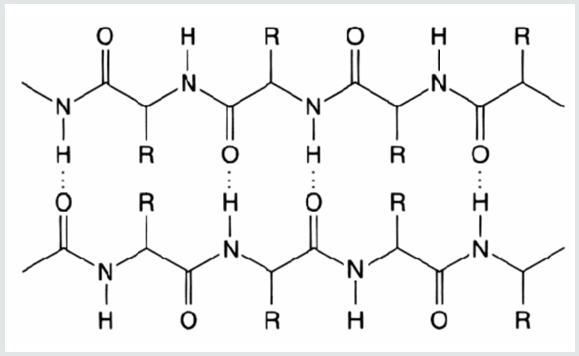Lupine Publishers | Journal of Research and Reviews on Health Care
Abstract
Eating foods high in protein gives the body the amino acids it needs to make keratin. Red meat, fish, chicken, pork, eggs, milk and yogurt all protein rich. The best plant sources of protein include beans, nut, Nat butters and quinoa. Most adults need two to three servings of protein each day to meet their daily requirements. Keratin is more of a restorative treatment borday says “Elen if you have a good hair type, it still strengthens the hair shaft and makes your hair mover salient. Sadock recommends checking with a demonologist before getting a keratin treatment if you have protasis or seborrheic dermatitis (Figure 1).
Keywords: Foods; Protein; Nut Butters; Strengthens; Keratin
Introduction
“Keratin treatment” has become the term of choice for hair- smoothing processes that leave your hair frizz-free for weeks (even months) but forget about the word keratin. “It’s just a make ting buzz word – it’s not doing anything to smooth the hair”, first, a quick chemistry lesson. Think of straight hair as a lader and curly hair as a spiral staircase. The steps on both are the hair’s bonds. If you break those bonds, you can rebuild the spiral stair case as ladder so curly hair becomes straight. Ammonium thiol collate and sodium hydroxide permanently break the bonds that’s how traditional relaxers and “jopynose straightening” treatments transform the texture of the hair, “these treatments last until your hair grows out, bat they can be damaging, say schaeller. (And they will subject you to a very awkward growing-out phase.) some “keratin treatment” (and the popular brozillinbleu out original solution) saturate the hair with of onal dehyde solution before its dried and flat ironed; the format dehyde (yes, it’s a suspected cancer gen for human) looks the hair into that straighter positions. Its stays smooth beyond your next shampoo. Your natural texture then gradually returns over two five months.
Materials and Methods
Keratin treatments won’t make your hair break, but the flatironing might. “The hair breakage has nothing to do with the treatments and everything to do with the flat irons that are used to dry and seal the hair a fleruard”, some stylists may use a flat iron that is way too hot and scorches hair making it break off”. Think of straight hair as a ladder and curly hair as a spiral staircase. The steps on both are the hair’s bonds. If you break those bonds. You can rebuild the spiral staircase as ladder-so curly hair becomes straight. No hair treatment will technically contain formaldehyde (because a little more chemistry you it’s a gas). What they are able contain are methylene glycol, formalin, methanol, and methane did – ingredients that release formaldehyde when heated or mixed with water. Several new hairs-smoothing treatments use glyoxylic acid (or a derivative of it) to lock the hair into a straighter position. Results don’t usually last more than two or three months and these treatments won’t dramatically soften your curl pattern the way formaldehyde solution can.
Biotin-Rich Foods
Biotin is needed to metabolize the amino acids that create keratin and is generally recommended to strengthen hair and nails. Dietary sources of biotin contain nut, beans, wholegrains, caul flower and mushrooms.
Foods with Vitamin A
Vitamin A is needed for keratin synthesis good dietary sources of vitamin A contain orange fruits and vegetables like pumpkin, sweet potatoes, butternut squash, raw carrots and cantaloupe. Kedgerees like spinach, kale and collards are also high in vitamin A. Boost your hair, nails and skin from within care for your precious hair by eating the right vitamins and foods that increase keratin production. Included is knowledge on why keratin is important and which foods and vitamins will offer the best support.
Increasing Keratin Production
a. Fruit and vegetable: It aren’t a surprise that increase keratin production include fruits and veggies. Produce that orange, such as mangoes, carrots, sweet potatoes, and cantaloupe are high in carotene, which helps your body produce keratin. Carotene can also found in spinach, green peppers and squash.
b. Meat and dairy: Iron-rich protein can boost the production of keratin in the body and improve the health of skin, hair and nails, liver, fish and lean meats build keratin in your body.
c. Iron rich foods: Iron-rich animal protein includes turkey, duck, chicken, pork, shrimp, eggs, lean beef and lamb. Plant foods that contain iron-rich protein include beans, spinach, black-eyed peas, soybeans, to fuand lenticls.
d. Vitamin C: foods rich in vitamin C include brocade, frazzles sprouts, kale, peppers, guava, papaya, grape fruit, oranges, pine apples, strawberries and lemons.
e. B vitamins: Foods with folate include a meal, fortified whole grain cereal, spinach, beets, parsnips, broccoli, okra, black-eye peas and soybeans.
f. Zinc: Consume foods with zinc, such as asters, crab, pork, ronde lain, turkey, veal, chicken, peanut butter, wheatgerm and chick peas.
Result and Discussion
Keratin treatments won’t make your hair break, but the flat-ironing might. No Nair treatment with technically contain formaldehyde (because - a little more chemistry you it’s a gas). Results don’t usually last more than two- or three-month biotin contain nut, beans, wholegrains, cauliflower and mushrooms. Vitamin A contain orange fruits and vegetables.
a. Like pumpkin, sweet potatoes.
b. Fruit vegetables
c. Spinach, green peppers and squash.
d. Meat and dour: liver, fish and lean meats build keratin in body.
e. Iron: beans, spinach, black-eyed peas, soybeans, tufa and lentils.
f. Vitamin C: include: broccoli, brussels sprouts kale, peppers, guava, papaya.
g. B vitamin: broccoli, okra, black-eye peas and soybeans.
h. Zink: turkey, veal, chicken, peanut, wheatgerm and chick peas.
Acknowledgement
I am thanking of my mother and father that support me. And news agency (Mehri, Fars, Isnad, Iran, Mojo, mina) and (Aftab- Yazd, redeemer, Khorasan) that published my subject science. And journal healthy house plant (Mrs. Julie Boudin Davis. of Dr. Alfred French and thanks that accepted my abstract for meeting. Of Prof. Hermann Hege am thanks that my subject used on university kiel Germany. Of kew garden (UK) am thanks that every month send your newsletter.
On finish of aces that every day send abstract journal and I was support to (Figure 2) and (Table 1).
Aspergillus Niger is one of the most important microorganisms in biotechnology. It has been already used to produce extracellular enzymes such as glucose oxidase, pectinase, α-amylase and glucoamylase, organic acids, and recombinant proteins. In addition, A. Niger is used for bio transformations and waste treatment [1-3]. Among the various enzymes produced by the fungus are included proteases. The major extracellular proteolytic activities in A. Niger appear to be due to acid proteases [4]. Acid proteases [E.C.3.4.23] are endopeptidases that depend on aspartic acid residues for their catalytic activity and show maximal activity at low ph. These enzymes offer a variety of applications in the food, beverage industry, and medicine [5]. Keratin is a fibrous protein that occurs in vertebrates and exerts protective and structural functions. It is the major component of feathers, wool, scales, hair, stratum corneum, horns, scalps, and nails [6]. Keratin is insoluble and presents high mechanic resistance, as well as recalcitrance to common proteolytic enzymes like pepsin, trypsin, and papain [7]. This resistance is because of the tight folding of protein chain in α-helix (α-keratin) and β-sheets (β-keratin) in a super-coiled polypeptide chain, kept by strong association by disulfide bonds [8,9]. Keratinases [EC 3.4.21/24/99.11] are specific proteases that display the capability of keratin degradation. These enzymes are gaining importance in the last years, with many applications associated with hydrolysis of keratinous substrates, mainly byproducts of agroindustry processes [10]. Generally, keratinases have optimum pH from neutral to alkaline [11]. The utilization of agroindustry wastes may represent an added value to the industry and meets the increasing awareness for energy conserving and recycling [12]. This fact stimulates the investigation for alternatives to convert keratinous waste into valuable products [10]. One example is the poultry industry that generates huge number of byproducts, which may represent a potential environmental hazard if they are incorrectly destined or processed. The processing and/ or treatment of slaughterhouse waste have been one of the great concerns of poultry industry, mainly because of the restrictions on environmental questions [13]. In this work, the production of proteolytic enzymes by a new keratinolytic strain of A. Niger was investigated. The enzyme activity was partially characterized, and a culture medium based on keratinous substrate was selected, evaluating the influence of growth substrate concentration and medium pH on the production of proteolytic enzymes (Figure 3).
Figure 3.

https://lupine-publishers-research.blogspot.com/




No comments:
Post a Comment
Note: only a member of this blog may post a comment.